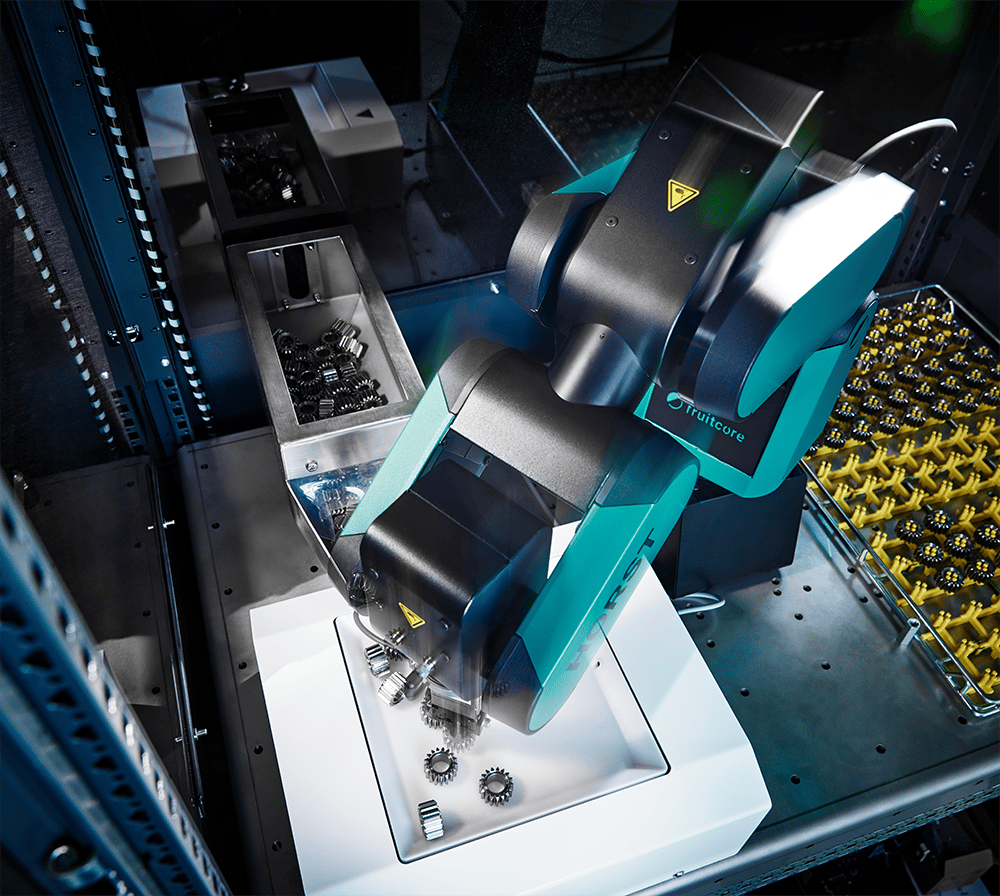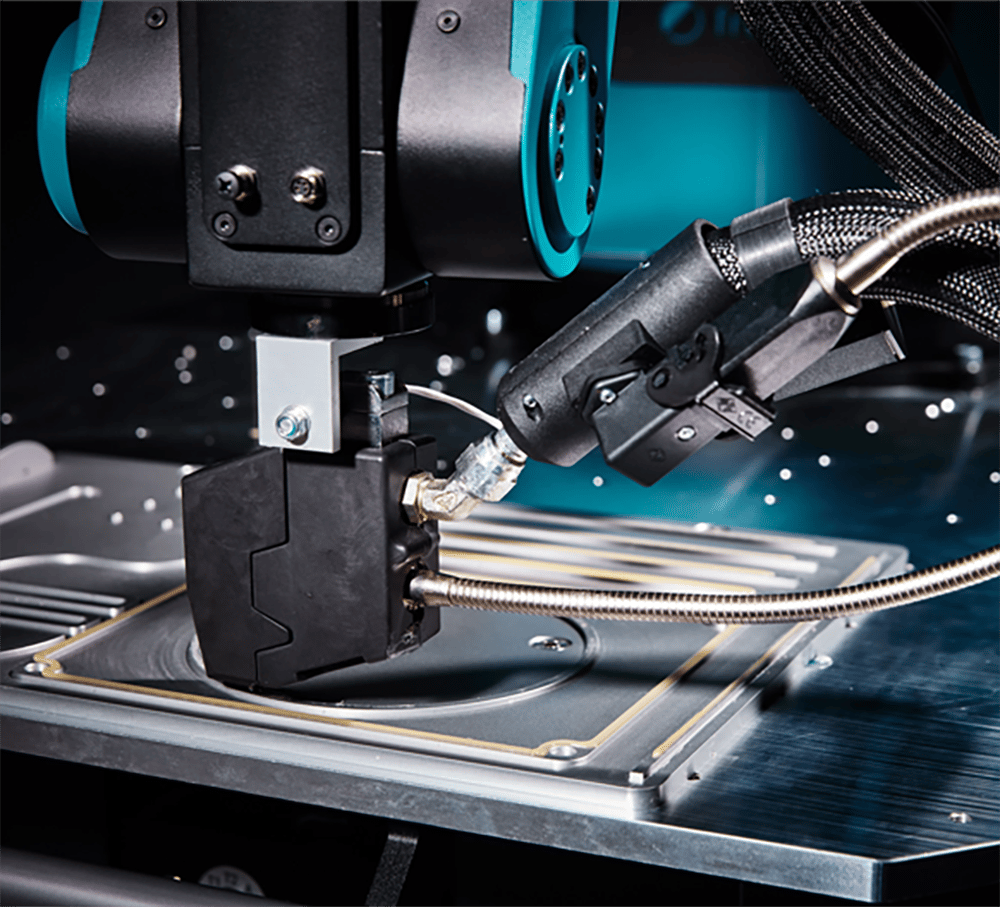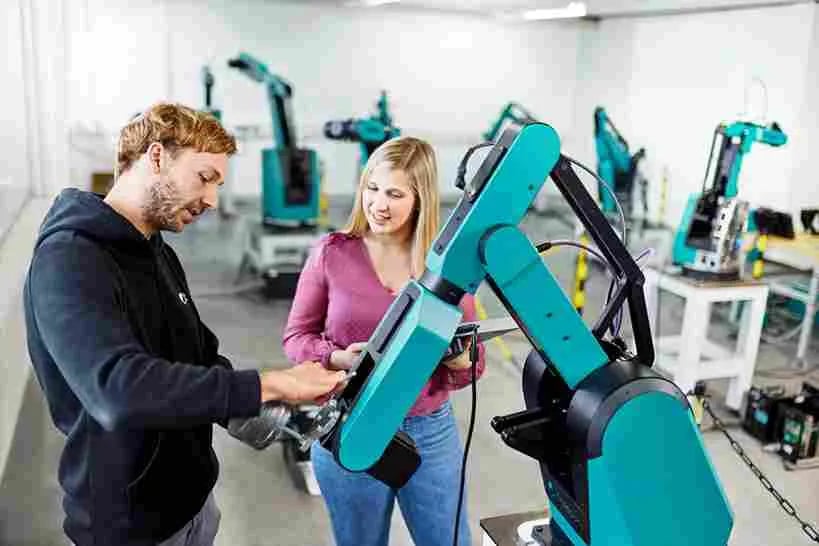Smart industrial robots or cobots? Discover the advantages of both worlds
Learn more about the differences between industrial robots and cobots in manufacturing. Find out which type of robot is the best choice for your challenges!

Smart industrial robot or cobot: Recognize the differences at a glance
Compare the benefits offered by industrial robots and cobots and check the advantages for your individual application.
| Intelligent industrial robots | Cobots | |
|---|---|---|
Service life |
Up to 100,000 hours in rated operation thanks to the use of durable planetary gearboxes |
Shaft gearboxes used last 25,000 to 50,000 hours in nominal operation. More susceptible to faults, e.g. due to built-in sensors |
Speed |
Higher speed (at least 4.3 m/s at the TCP), maximizes productivity and the company's results |
Mandatory reduced speed in collaborative use for the safety of persons, actual speed dependent on risk assessment |
Economic efficiency |
Rapid amortization after 3 to 6 months, low acquisition, operating and maintenance costs |
Longer amortization due to higher acquisition costs, higher costs over the entire service life (shorter service life, more susceptible to maintenance) |
Risk assessment |
Simple thanks to modular and protected robot platforms and other safety systems; external safety sensors (e.g. light barriers) enable risk-free collaboration |
Easier in collaborative operation due to sensors already installed; retrofit safety systems often required for industrial applications |
Precision |
Very precise thanks to measuring sensors on the final drive, no re-teaching due to wear |
Drive components designed less for precision than for flexibility and collaboration options |
Flexibility |
Automation modules for many applications allow quick switching between tasks |
High, as designed for various tasks |
Forms of human-robot collaboration: from collaboration to full automation
In addition to collaboration, there are other levels of cooperation between humans and robots. The most common in industry are coexistence and cooperation (synchronized division of labor). Here, sensors detect whether someone is approaching the robot. If necessary, the robot reduces its speed. As with safety fences and barriers, this enables a higher level of performance than with collaboration.
Fully automated: Field of application of conventional industrial robots
In a fully automated system, robots or machines perform all tasks without humans. These systems are usually specialized and perform the same task repeatedly around the clock.
Advantages
- High production rate: Continuous work capability without interruptions
- Consistency and quality: No human error
- Safety: No dangerous or harmful tasks are performed
Disadvantages
- High initial investment: Expensive set-up of robots, machines and software
- Less flexibility: Difficult to reprogram for other tasks
- Possible job loss: Replacement of personnel theoretically possible
Coexistence: area of application for intelligent industrial robots
In this mode, humans and robots share the same physical space but do not interact directly with each other. Each carries out its own tasks independently of the other.
Advantages
- Simple integration: no complex safety measures required
- Independence: Human workers are not disturbed
- Cost efficiency: Lower requirements for safety infrastructure
Disadvantages
- Limited synergy: No hand-in-hand collaboration between humans and robots
- Underutilization: Potential for increased efficiency is not exploited
- Possible isolation: Human workers may feel isolated
Cooperation: Field of application for intelligent industrial robots
Humans and robots work in the same space and at the same time, but on different tasks. They can complement each other, but they do not work on the same task.
Advantages
- Efficiency: Parallel execution of tasks
- Flexibility: Adaptable to different tasks
- Division of labor: Efficient distribution of tasks between humans and robots
Disadvantages
- Safety risks: Potential hazards if handled improperly
- Coordination required: Requires good planning and communication
- Costs for safety measures: Additional investment may be required
Collaboration: area of application for cobots
Here, humans and robots work hand in hand, often on the same task. Special, integrated sensors and software enable safe and low-risk collaboration.
Advantages
- Synergy: Combination of the characteristics of humans and robots
- Adaptability: Flexible and easy to reprogram.
- Innovation potential: Enables new working methods and processes.
Disadvantages
- Lack of robustness: Frequent maintenance due to design and failure-prone sensors for protection
- Costs: Higher initial investment due to complex sensor technology and partly hidden costs during commissioning
- Performance: Collaborative operation only possible with greatly reduced speed
Exclusive special offer for our HORST1400 robot
Now for only € 17,250 instead of € 22,995
We are making space in our warehouse and are offering HORST1400 at a reduced price for a short time.
Do you want to load and unload distant machines or use heavy tools? Then you will be impressed by the reach and load capacity of this robot. Thanks to its innovative drive technology, it makes maximum use of its performance capabilities.
Why should you choose the intelligent industrial robot HORST?
Highest economic efficiency
4 times longer service life, lower operating and maintenance costs than cobots.

Lower acquisition costs
No unnecessary sensors for cobot operation, no hidden costs during commissioning.

Performance suitable for industry
Significantly higher speeds than in cobot operation, which must be restricted by the Machinery Directive.

Simpler risk assessment
Completed risk assessment through modular and safe robot platforms; no hidden subsequent safety precautions.

Reliable precision
Measuring sensors are located on the final drive, no reteaching necessary due to wear.

In which areas HORST will help you solve your challenges
Find out more about the smart way of automation with intelligent industrial robots and for which tasks you can use HORST.

Machine loading
- In a highly competitive market, quality is crucial. HORST enables high accuracy when picking and placing workpieces, which improves product quality and reduces waste.
- Employee safety is of paramount importance. HORST can be used for hazardous or unhealthy tasks, reducing the risk of workplace accidents.
- In today's fast-paced production world, flexibility is key. HORST can be quickly adapted to changing tasks and production scenarios.

Separation of parts
- Accuracy when sorting parts is crucial for the quality of the end product. HORST offers an extremely high repeatability of ±0.05 mm, which enables precise separation.
- Manual processes can be time consuming and inefficient. HORST enables faster and continuous feeding of bulk material without the need for constant operator intervention.
- In an ever-changing market, the ability to adapt quickly is crucial. HORST is designed to meet a wide range of requirements.

Quality inspection
- Consistency in quality inspection is critical to the reliability of the end product. HORST provides precisely defined movements and minimizes external influences, enabling precise and consistent quality inspection.
- Being able to detect quality defects in complex surfaces is critical for many industries. HORST can be equipped with a camera and offers flexible 6-axis kinematics to inspect complex surfaces from different angles.
- Quickly and cost-effectively adapting to new processes or applications is essential for a company's competitiveness. HORST enables simple adaptations, even for the smallest series.

Dosing and gluing
- The HORST 6-axis industrial robot enables complex dispensing movements and adapts effortlessly to uneven or curved geometries. This enables precise dispensing and application of adhesives or other materials.
- HORST can easily be equipped with different end effectors to handle or inspect the component in addition to dispensing. It can be seamlessly integrated into your entire production environment.
- With the horstOS software feature for creating complex paths and the use of artificial intelligence and machine learning, our smart industrial robot offers maximum efficiency in your dispensing and gluing processes.

Assembly
- HORST achieves high speeds and is extremely repeatable (±0.05 mm). This makes HORST ideal for assembly processes that require short cycle times and high precision.
- HORST can be used in hazardous or chemical environments, reducing the risk to assembly workers. It can also be equipped with various grippers, tools or sensors to achieve the optimum process flow.
- HORST utilizes the latest technologies such as artificial intelligence and machine learning and offers full connectivity into existing systems and processes
Case study: Why an SME in the metalworking industry opts for an industrial robot
Costly, time-consuming and monotonous work? With HORST1400, this has finally come to an end!
Cyfa-Tech, a Swiss manufacturer of complex milled parts, has achieved an enormous increase in efficiency with our smart industrial robot HORST1400: while the robot unmannedly loads a CNC machine, the employees can now devote themselves to other tasks. HORST1400 has already paid for itself after 3 months. This will not be the last project with a HORST for the up-and-coming specialist in the hydraulics industry!

Ready for the next level of automation? Get in touch with us
Our robotics experts are always ready to talk to you about your specific needs. Let's talk about the best, most economical and sustainable solution for your company!
FAQ: What you always wanted to know about HORST
-
Why isn't HORST called KLAUS or OSKAR?
Firstly, the name HORST stands for being the friendly colleague in your company. HORST is a helper that relieves your employees of monotonous, dangerous or unhealthy tasks - it doesn't take their work away! At fruitcore robotics, we have deliberately opted for a catchy first name instead of a cryptic designation for our smart industrial robots, which also makes it clear that HORST stands for Made in Germany. HORST actually stands for Highly Optimized Robotic Systems Technology. This symbolizes how we at fruitcore robotics make powerful and complex deep-tech systems simple and accessible for you.
-
What does smart industrial robot mean?
Industrial robots have been around for decades. However, our smart industrial robots no longer have much to do with these giant machines. HORST models are characterized by the fact that they are economically sustainable, intuitive to operate and program and easy to set up and integrate. They can also be used flexibly in almost all industries and for a wide range of applications - regardless of the size of the company or previous experience with automation. -
Is HORST a cobot?
First things first: HORST can work together with humans! There are different levels of collaboration between humans and robots. The most common stages in industrial practice are coexistence and synchronized division of labor. Sensors are used to detect the presence of humans in the vicinity of the robot and, if necessary, the speed of the robot is reduced to a standstill. This allows, for example, parts to be provided for the robot or transported to the next process step after processing by the robot. Just like the use of protective fences and grids, coexistence and synchronized division of labour enable high robot speeds. This leads to consistently high productivity and further increases in productivity - the primary goals when using industrial robots. The manual guidance of robots for programming paths is charming to look at and very playful - it works perfectly, especially in demo applications and for rough pre-programming. In industrial practice, the reduced maximum speed of cobots and other challenges, such as handling dangerous, pointed or sharp-edged workpieces, often speak against the use of cobots. This has led us at fruitcore robotics to develop smart industrial robots: programming is carried out for both simple and extensive programs using a sophisticated programming concept, graphical or textual programming. The safety controller can be easily connected to safety sensors such as laser scanners or light barriers. The monitored stop as well as speed and distance monitoring make it possible to work manually from an adjacent work area or alternate with automated operation. As a result, HORST smart industrial robots offer you simple operation combined with an attractive ROI.
-
Why is HORST a particularly durable industrial robot?
Thanks to their innovative drive, our smart industrial robots have an exceptionally long service life and are also virtually maintenance-free. The key to a long robot service life lies in the type of gearbox. In practice, thanks to HORST's unique gearboxes, a service life of at least 50,000 hours can be assumed, even under high loads and with long operating times. This corresponds to more than five years! The shaft gearboxes usually installed in industrial robots last on average between 7500 and 10,000 hours at nominal load. -
Which sectors is HORST suitable for?
HORST is already used in hundreds of applications and areas of industry. It is used in the processing of metals or rubber and plastic goods as well as in mechanical engineering, medical technology and the electrical and electronics industry. Our smart industrial robots are not limited to specific sectors. Simply contact us and we will support you in your industry too. -
In which application areas does HORST feel at home?
Our smart industrial robots are designed for maximum flexibility - this also applies to the tasks you can tackle with HORST. Regardless of whether you want to automate your machine loading, parts separation, quality inspection or any other application: HORST will support you in such a way that the step towards automation becomes economical, sustainable and user-friendly for your company from A to Z. You can also use our intelligent industrial robots for the efficient and precise application of adhesives or dosing and let HORST support you in assembly. Find out more about the areas of application for our smart industrial robots in this overview.
-
In which countries is HORST available and can I export it abroad?
You can purchase our smart industrial robots within Europe. Contact our sales experts for specific questions about purchasing a HORST from other countries outside the EU.
-
How long does it take for HORST to reach you after ordering and how does the payment process work?
With HORST, you can forget long waiting times and delivery periods of up to 30 weeks (as with other manufacturers): With fruitcore robotics, it only takes a few days or weeks from ordering to the start of operation. We can deliver immediately, not least thanks to the Made-in-Germany principle! You can find out how we achieve this here.
Talk to experts now
fruitcore robotics GmbH
Macairestraße 3
78467 Konstanz
+49 (0) 7531 976 240
info@fruitcore.de




![STORZ MEDICAL AG-Logo Pantone 5565 [Converted]-2](https://26525447.fs1.hubspotusercontent-eu1.net/hub/26525447/hubfs/STORZ%20MEDICAL%20AG-Logo%20Pantone%205565%20%5BKonvertiert%5D-2.webp?width=727&height=86&name=STORZ%20MEDICAL%20AG-Logo%20Pantone%205565%20%5BKonvertiert%5D-2.webp)





